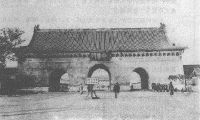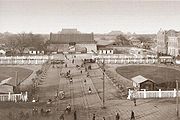
Gate of China, Beijing
Encyclopedia

The Gate of China in Beijing was a historical ceremonial gateway in Beijing
Beijing
Beijing , also known as Peking , is the capital of the People's Republic of China and one of the most populous cities in the world, with a population of 19,612,368 as of 2010. The city is the country's political, cultural, and educational center, and home to the headquarters for most of China's...
, China
China
Chinese civilization may refer to:* China for more general discussion of the country.* Chinese culture* Greater China, the transnational community of ethnic Chinese.* History of China* Sinosphere, the area historically affected by Chinese culture...
, located near the centre of today's Tiananmen Square
Tiananmen Square
Tiananmen Square is a large city square in the center of Beijing, China, named after the Tiananmen Gate located to its North, separating it from the Forbidden City. Tiananmen Square is the third largest city square in the world...
. It was demolished in 1954. This gate formed the southern gate of the Imperial City
Imperial City (Beijing)
The Imperial City is a section of the city of Beijing in the Ming and Qing dynasties, with the Forbidden City at its center. It refers to the collection of gardens, shrines, and other service areas between the Forbidden City and the Inner City of ancient Beijing...
during the Ming
Ming Dynasty
The Ming Dynasty, also Empire of the Great Ming, was the ruling dynasty of China from 1368 to 1644, following the collapse of the Mongol-led Yuan Dynasty. The Ming, "one of the greatest eras of orderly government and social stability in human history", was the last dynasty in China ruled by ethnic...
and Qing
Qing Dynasty
The Qing Dynasty was the last dynasty of China, ruling from 1644 to 1912 with a brief, abortive restoration in 1917. It was preceded by the Ming Dynasty and followed by the Republic of China....
dynasties. It was situated on the central axis of Beijing, to the north of Qianmen Gate
Qianmen
Qianmen is the colloquial name for Zhengyangmen , a gate in Beijing's historic city wall. The gate is situated to the south of Tiananmen Square and once guarded the southern entry into the Inner City. Although much of Beijing's city walls were demolished, Qianmen remains an important...
and south of Tiananmen
Tiananmen
The Tiananmen, Tian'anmen or Gate of Heavenly Peace is a famous monument in Beijing, the capital of the People's Republic of China. It is widely used as a national symbol. First built during the Ming Dynasty in 1420, Tian'anmen is often referred to as the front entrance to the Forbidden City...
. Unlike these two defensive gates, the Gate of China was a purely ceremonial gateway, with no ramparts, but was a brick-stone structure with three gateways.
History
The gate was first built in the YongleYongle Emperor
The Yongle Emperor , born Zhu Di , was the third emperor of the Ming Dynasty of China from 1402 to 1424. His Chinese era name Yongle means "Perpetual Happiness".He was the Prince of Yan , possessing a heavy military base in Beiping...
period of the Ming dynasty
Ming Dynasty
The Ming Dynasty, also Empire of the Great Ming, was the ruling dynasty of China from 1368 to 1644, following the collapse of the Mongol-led Yuan Dynasty. The Ming, "one of the greatest eras of orderly government and social stability in human history", was the last dynasty in China ruled by ethnic...
. As it was the southern gate of the Imperial City, and in ancient China "south" was regarded as the most eminent direction, this gate enjoyed a status as "Gate of the Nation". Its name has changed as dynasties rose and fell. In the Ming dynasty it was known as the "Great Ming Gate", and bore a set of engraved couplets "The Sun and Moon illuminate the virtues of Heaven; The Mountains and Rivers make magnificent the home of the Emperor" (“日月光天德,山河壯帝居”). When the Qing dynasty
Qing Dynasty
The Qing Dynasty was the last dynasty of China, ruling from 1644 to 1912 with a brief, abortive restoration in 1917. It was preceded by the Ming Dynasty and followed by the Republic of China....
replaced the Ming, the gate's name was accordingly changed to the "Great Qing Gate" ' onMouseout='HidePop("89419")' href="/topics/Manchu_language">Manchu
Manchu language
Manchu is a Tungusic endangered language spoken in Northeast China; it used to be the language of the Manchu, though now most Manchus speak Mandarin Chinese and there are fewer than 70 native speakers of Manchu out of a total of nearly 10 million ethnic Manchus...
: Daicing duka) in 1644. After the fall of the Qing dynasty in 1912, the gate's name was changed to the "Gate of China". In 1952, with the expansion of Tiananmen Square
Tiananmen Square
Tiananmen Square is a large city square in the center of Beijing, China, named after the Tiananmen Gate located to its North, separating it from the Forbidden City. Tiananmen Square is the third largest city square in the world...
, consultants from the Soviet Union
Soviet Union
The Soviet Union , officially the Union of Soviet Socialist Republics , was a constitutionally socialist state that existed in Eurasia between 1922 and 1991....
recommended demolishing the gate. In 1954 the gate was demolished. In 1976, after the death of Mao Zedong
Mao Zedong
Mao Zedong, also transliterated as Mao Tse-tung , and commonly referred to as Chairman Mao , was a Chinese Communist revolutionary, guerrilla warfare strategist, Marxist political philosopher, and leader of the Chinese Revolution...
, a mausoleum was built for him on the site of the former gate.
Architecture

Plaza
Plaza is a Spanish word related to "field" which describes an open urban public space, such as a city square. All through Spanish America, the plaza mayor of each center of administration held three closely related institutions: the cathedral, the cabildo or administrative center, which might be...
before it, two lions on each side, and a "dismounting stele
Dismounting stele
A dismounting stele, in East Asian architecture, was a stele erected outside an important building or group of buildings giving notice for mounted travellers to dismount and for passengers of vehicles to exit the vehicle.-Locations:...
" on each side ("大清門,三闕上為飛簷崇脊,門前地正方,繞以石欄,左右獅各一,下馬石碑各一"). It is similar in style to the Great Red Gate at the Ming Dynasty Tombs
Ming Dynasty Tombs
The Ming Dynasty Tombs are located some 51.35 kilometers due north of central Beijing, within the suburban Changping District of Beijing municipality...
and imperial tombs of the Qing dynasty.
In the Qing dynasty, the space between the Great Qing Gate and the Zhengyang Men
Qianmen
Qianmen is the colloquial name for Zhengyangmen , a gate in Beijing's historic city wall. The gate is situated to the south of Tiananmen Square and once guarded the southern entry into the Inner City. Although much of Beijing's city walls were demolished, Qianmen remains an important...
was a square plaza surrounded by a stone fence. During the Ming dynasty
Ming Dynasty
The Ming Dynasty, also Empire of the Great Ming, was the ruling dynasty of China from 1368 to 1644, following the collapse of the Mongol-led Yuan Dynasty. The Ming, "one of the greatest eras of orderly government and social stability in human history", was the last dynasty in China ruled by ethnic...
, this space had been a busy market place, called "Chessgrid Streets" because of the narrow alleys between stalls.
The Dismounting Steles outside the gate marked the place where officials must exit from their sedan chairs or dismount from horses.
Only the Emperor, Empress, and Empress Dowager were allowed to ride in sedan chairs through the gate. In the Qing dynasty, the Empress may only enter the Forbidden City
Forbidden City
The Forbidden City was the Chinese imperial palace from the Ming Dynasty to the end of the Qing Dynasty. It is located in the middle of Beijing, China, and now houses the Palace Museum...
via the Great Qing Gate on the occasion of her wedding. All other concubines and consorts had to enter via the north gate, the Gate of Divine Might
Gate of Divine Might
The Gate of Divine Might or Gate of Divine Prowess is the northern gate of the Forbidden City in Beijing, China. It faces Jingshan Park. A tablet above the doorway reads "The Palace Museum" in Chinese....
.
Tablet
The main tablet hanging above the gate was carved out of stone, with the individual characters made of Lapis lazuliLapis lazuli
Lapis lazuli is a relatively rare semi-precious stone that has been prized since antiquity for its intense blue color....
and fitted into the tablet. On October 9, 1912, the day before the one year anniversary of the Xinhai Revolution
Xinhai Revolution
The Xinhai Revolution or Hsinhai Revolution, also known as Revolution of 1911 or the Chinese Revolution, was a revolution that overthrew China's last imperial dynasty, the Qing , and established the Republic of China...
, the Republic of China
Republic of China
The Republic of China , commonly known as Taiwan , is a unitary sovereign state located in East Asia. Originally based in mainland China, the Republic of China currently governs the island of Taiwan , which forms over 99% of its current territory, as well as Penghu, Kinmen, Matsu and other minor...
government decided to change the name to "China Gate" to celebrate the overthrow of imperial power. It was thought that they could simply take down the tablet, reverse it, and carve the new name on it. When the stone was taken down, however, they discovered that the inside was inscribed "Great Ming Gate": it seems the Qing artisans had already thought of the idea two hundred years ago. So a wooden tablet was quickly made, and the mayor of Beijing wrote the three characters "中華門" (Gate of China).
The original stone tablet is now in the Capital Museum in Beijing.
See also
- Gate of China, NanjingGate of China, NanjingThe Gate of China in Nanjing , was a ceremonial gateway in Nanjing, China. It was the southern gate of Nanjing city. It is a renowned ancient city gate in China and the city gate with the most complex structure in the world.-History:...

